June 3, 2025 | 18:17 GMT +7
June 3, 2025 | 18:17 GMT +7
Hotline: 0913.378.918
June 3, 2025 | 18:17 GMT +7
Hotline: 0913.378.918
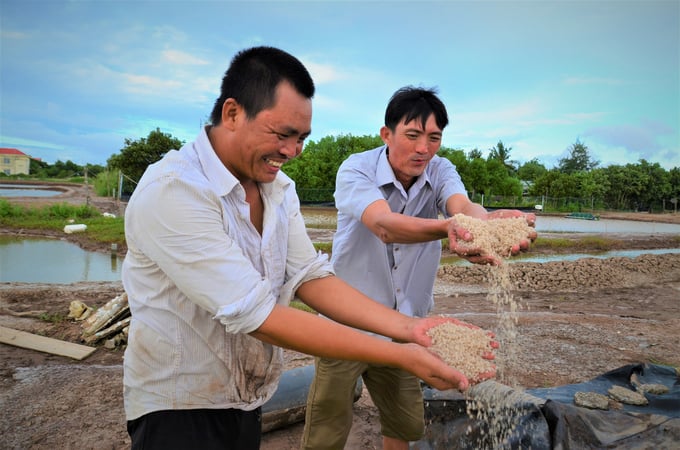
Mr. Nguyen Thanh Sang and Mr. Nguyen Thanh Mong in Vinh Thinh commune, Hoa Binh district, Bac Lieu province, are examining the grains of pink salt. Photo: Duong Dinh Tuong.
During a fortuitous occasion, Dr. Ngo Kieu Oanh, an expert in agriculture and tourism, was invited by the Global Environment Fund, a non-governmental organization under the United Nations, to visit the salt fields of Hoa Binh district and Dong Hai district in Bac Lieu province. The purpose of this journey was to delve into the intricacies of salt production and explore avenues to enhance livelihoods for local residents, including embellishing homes, crafting rustic incense, and fostering experiential salt-themed tourism. Upon arrival, local officials directed her attention towards a popular variant of salt, known for its high yield and the exquisite beauty of its pure, white grains.
Curiously, the United Nations-affiliated delegation held reservations about this prevalent type of salt due to concerns of potential plastic waste accumulation, envisioning micro-plastic particles intermingling within the salt crystals. Their interest solely centered on artisanal salt production. However, the craft of artisanal salt-making in Bac Lieu has been dwindling. Its decline can be traced primarily to the local nomenclature, referring to it as "muối đất" (soil salt) or "muối đen" (black salt), inadvertently perpetuating the perception of impurity among consumers.
Dr. Ngo Kieu Oanh emphasized: "We should rebrand it as ‘Bac Lieu pink salt’ due to its pink hue and genuine aesthetic appeal. While in the Northern region salt is sun-dried on sandy surfaces, in the South, it is sun-dried atop alluvial soils. This pink salt variety is sourced from the mineral-rich waters of coastal estuaries, crystallizing naturally on alluvial substrates."
Moreover, according to international documentation, alluvial soils often contain abundant precious minerals such as gold and platinum, along with other gemstones, thereby conferring distinct health benefits. The artisanal salt of Bac Lieu, derived from the infusion of alluvial seawater, boasts a pinkish-white hue, solid dry grains, devoid of impurities and odors, without a bitter taste, and with a sweet aftertaste.
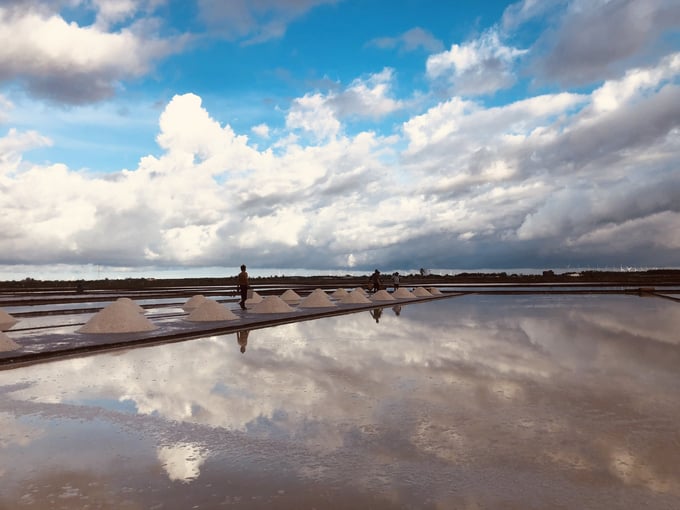
Pink salt fields of Bac Lieu. Photo: Phan Thanh Cuong.
Each jar of Himalayan pink salt from Pakistan, weighing 110 grams and sold in the Vietnamese market for 60,000 VND, is a mineral extracted from mines. In contrast, 1 kilogram of Bac Lieu pink salt, characterized by its large and beautiful grains, sourced from seawater, costs only 3,000 to 4,000 VND. This vast difference, amounting to hundreds of times, stems from the fact that Vietnamese individuals have yet to narrate the story of salt as passionately as the people of Pakistan and India have. The unique nutritional value of Bac Lieu pink salt's grains remains relatively unadvertised, resulting in the ironic situation of holding what seems like "gold" in their hands, yet believing it to be ordinary soil. In the past, the affluent gentleman from Bac Lieu was among the first ordinary Vietnamese citizens to possess a private airplane, owing his fortune to both rice and salt cultivation.
Currently, many individuals in the market are selling industrial salt or unprocessed raw salt extracted from mines, which contain numerous unprocessed metals for culinary use. The primary component of both natural and industrial salt is NaCl; however, the excessive intake of sodium into the body, coupled with the scarcity of naturally occurring oceanic trace minerals, contributes to elevated blood pressure, cardiovascular ailments, and thyroid-related conditions. Salt, with high salinity, includes industrial salt and imported mined salt, whereas sea salt, produced using traditional manual methods within the country, boasts lower salinity and higher levels of beneficial minerals that promote well-being, etc.
The salt-making trade in Bac Lieu boasts a centuries-old legacy, renowned during the French colonial era for its "muối Ba Thắc" or Bassac salt product. In 2019, Bac Lieu salt was officially certified with a geographical indication by the Intellectual Property Office. In 2020, the art of salt-making in Bac Lieu was recognized as an intangible national cultural heritage. In 2021, Bac Lieu province organized a ceremony to officially acknowledge this intangible cultural heritage in Dong Hai district. Mr. Phan Van Phuc, a local resident of Vinh Thinh commune, Hoa Binh district, was a representative who attended and received commendation for his dedication.

Mr. Phan Van Phuc's salt storage house - a salt worker in Vinh Thinh commune. Photo: Duong Dinh Tuong.
At the age of 70, Mr. Phuc has spent 50 years in the salt trade, earning him the title of a modern "salt king." A decade ago, he managed up to 50 hectares of salt fields, yielding an impressive 90,000 catties per harvest. Now, these salt fields have been divided among his offspring, leaving him with only 18 hectares. Half of this land is dedicated to high-yield salt cultivation using tarp, while the other half adheres to the traditional manual method on soil beds. The high cost and scarcity of laborers persist as challenges since salt production is labor-intensive and lacks mechanical support comparable to rice farming. The demanding processes of levelling, raking, and carrying are all strenuous tasks. Moreover, traditional salt grains are being heavily overshadowed by imported salt grains, both in export and domestic markets.
"In the past, salt prices would remain high for six consecutive months, only to drop in the following season with the arrival of new harvest. Nowadays, as soon as salt prices slightly rise, within just a month, industrial salt from China and India floods in, fierce competition drives prices down. Although this salt has high salinity, it's bitter and harsh, unlike the mild, delicate taste of our locally-produced salt," Mr. Phuc laments.
Amid the scorching weather, Mr. Nguyen Van Bac sits bare-chested inside his humble home. Born in 1945, he grew up in Vinh Tien hamlet, Vinh Thinh commune, Hoa Binh district, Bac Lieu province. At the age of 17, he commenced his salt-making journey, accumulating an impressive 58 years in the trade.
"The salt-making process can be excruciatingly tough, to the point where sweat on our backs turns into tiny grains of salt, both salty and bitter. Yet, the unique aspect of this region is that people raise shrimp that 'eat' money, pigs that 'consume' soil, and we lose everything for the sake of salt production. There's little profit and even less consolation," Mr. Bac shares.
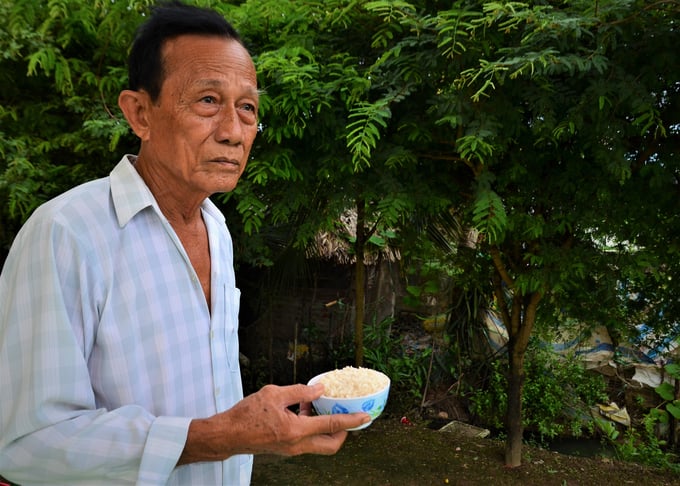
Mr. Nguyen Van Bac - a salt worker in Vinh Thinh commune, pictured next to a mound of pink salt. Photo: Duong Dinh Tuong.
With 4 hectares of salt fields, Mr. Bac typically produces over 2,000 catties of salt per harvest, with a record of up to 3,000 catties. Each mature catty of salt, consisting of dense and solid grains, weighs 40 kg. Each young catty of salt, with fluffy and lightweight grains, weighs 35 kg. In the past, there was salt but no market price. In recent years, there's a price, yet sometimes no salt. Last year, relentless rain persisted until the 29th of Tet (Lunar New Year), causing salt production failure. Mr. Bac managed to collect only 850 catties. The cost of hiring laborers for scraping and carrying each catty of salt amounted to 9,000 VND, while the selling price is around 51,000 VND.
Due to the responsibility of raising 11 children, Mr. Bac had to sell one hectare of salt field to repay debts. Out of the 11 children, only his youngest son, Mr. Nguyen Van Loi, aged 31, follows his father's salt-making trade. Even under the scorching sun, he must expose his back to the fields, as salt-making requires sunlight. In the past, a salt harvest season lasted for three months, but now it's reduced to two months due to climate changes and unpredictable rain and wind.
In October, when the water recedes, they dig trenches, plow and level the fields, then carry heavy clay soil to flatten the land before refilling it with water. Under the sun's influence, about 45-50 days after the water is filled, it evaporates, and then they add brine to thicken it. After waiting for 10-15 days, the first round of salt harvesting begins. The subsequent rounds take another 9-10 days. With three or four harvesting cycles like this, the salt season ends in three months. Due to poverty and the inability to afford tarps like others, Mr. Bac still employs manual methods to create salt without covering the fields.
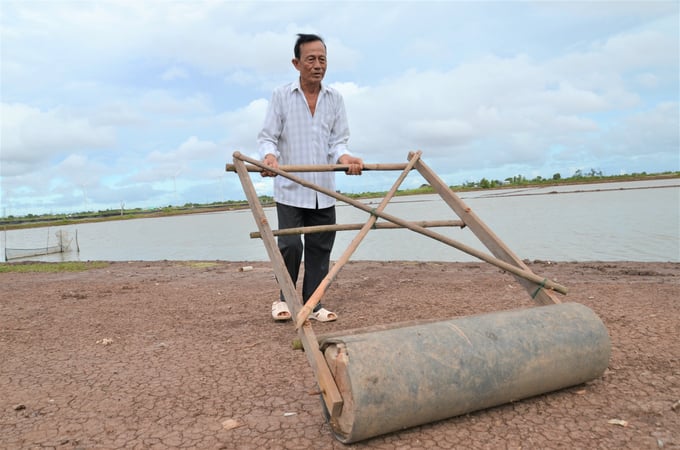
Mr. Nguyen Van Bac is seen pushing a cart to distribute clay soil for the salt fields. Photo: Duong Dinh Tuong.
Each square meter of tarp costs more than 30,000 VND, and when factoring in the expenses for adhesive and labor, covering three hectares of salt fields requires around 250-300 million VND - an amount that, at nearly 80 years old, Mr. Bac doesn't even dare to dream of having, let alone possess. Using tarp for salt production yields twice the output compared to the traditional soil method. Moreover, the salt produced this way maintains a pristine white color, resembling rice, and is highly favored, with a selling price of over 4,000-5,000 VND per kilogram, whereas pink salt only sells for 3,000 to 4,000 VND per kilogram.
Both the older and younger generations are disheartened by salt in general, especially the traditional soil-made salt. Mr. Nguyen Thanh Sang in Vinh Tien hamlet inherited the soil-made salt craft from his father but had to switch to tarp-covered salt fields after a few years.
In 2021, he harvested 20 tons, and in 2022, the yield increased to over 30 tons. He doesn't sell to wholesalers at the 3,000 VND/kg price; instead, he retails the salt to local residents within the commune or district for 4,000 VND/kg.
"Even if the price of soil-made salt matches that of tarp-covered salt, I would still opt for tarp-covered salt because it involves less labor. You only need to spread it out once on the field, while for soil-made salt, every harvest and leveling requires rolling multiple times. After rolling, you have to wait 2-3 days for the ground to harden before adding water. In contrast, with tarp-covered salt, you just lift it up and put it directly into the water," he explains.
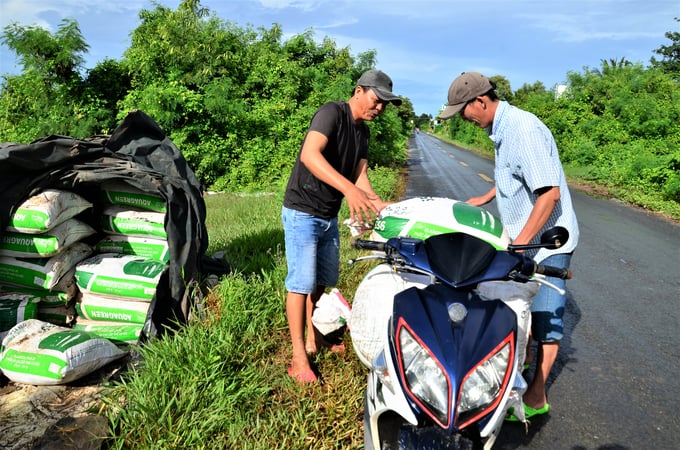
Mr. Nguyen Thanh Sang and Mr. Nguyen Thanh Mong from Vinh Thinh commune loading bags of pink salt onto a vehicle for retail. Photo: Duong Dinh Tuong.
Throughout the entire afternoon, I sat and listened to the grievances and bitter experiences of manual salt-making. It wasn't until evening, while sitting at the home of Mr. Co Tan Xuyen - the Head of the Department of Agriculture and Rural Development of Hoa Binh District, Bac Lieu Province, that I heard an abundance of pioneering and bold stories within this craft. It was then that a glimmer of hope shone through, revealing a small beacon of light at the end of the tunnel for pink salt. (To be continued)
Producing pink salt on clay soil typically takes around 15 days for one harvest, whereas for tarp-covered white salt, it only takes 7 days to be ready for collection. Moreover, the yield of tarp-covered white salt is twice as much, and its selling price consistently exceeds 700 to 800 VND/kg.
Translated by Nguyen Hai Long

(VAN) TTC AgriS and IFC signed a strategic partnership to develop a sustainable agricultural value chain, aiming to achieve the Net Zero target by 2035.

(VAN) Seafood by-products are opening a new path, combining green growth and technological innovation to enhance the industry's value.

(VAN) Mr. Nguyen Thanh Cong, Vice Chairman of the Son La Provincial People's Committee, reflects on Son La’s journey from barren hills to fruitful orchards after a decade of hard work.
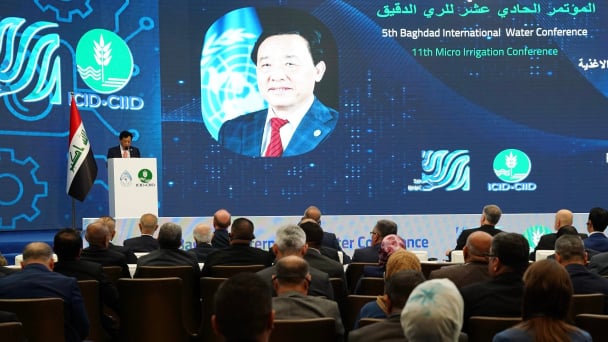
(VAN) FAO’s Director-General addresses the 5th Baghdad International Water Conference.
/2025/05/26/1716-4-nongnghiep-191706.jpg)
(VAN) Chain linkages, technological innovation, and raw material zoning are three strategic pillars for the coconut industry to strongly develop and elevate its position on the global agricultural map.
![Advanced mariculture – an inevitable trend: [4] Accompanied by scientists](https://t.ex-cdn.com/nongnghiepmoitruong.vn/608w/files/sohk/2025/05/13/1941-pgsts-vo-van-nha-140958_717.jpg)
(VAN) According to Assoc. Prof. Dr. Vo Van Nha, Director of the RIA III, the development of advanced offshore mariculture is no longer an option but an essential path for Vietnam’s fisheries sector.

(VAN) Vietnam is intensifying the development of mollusk farming areas that meet international standards, aiming for sustainable growth and enhancing its export position in the global seafood market.